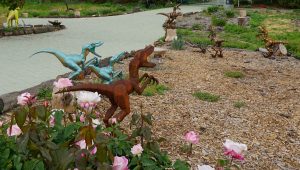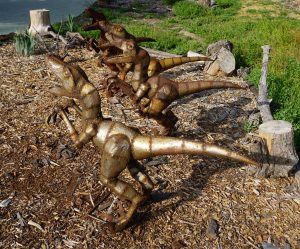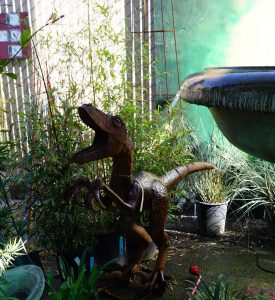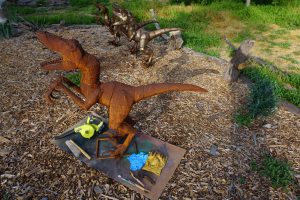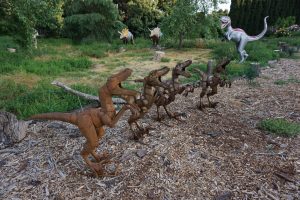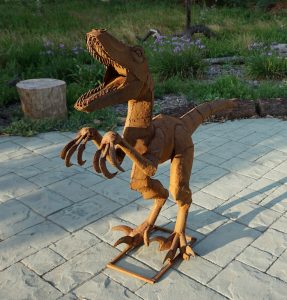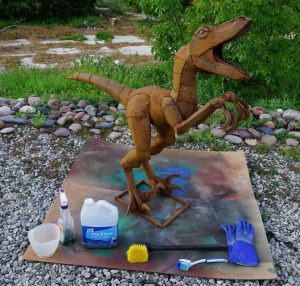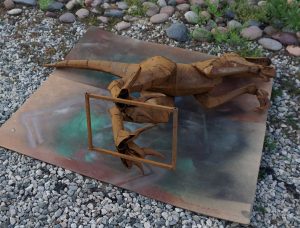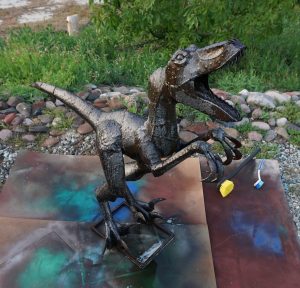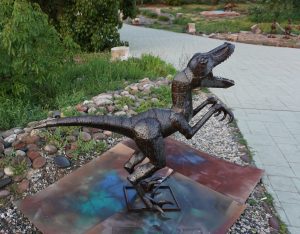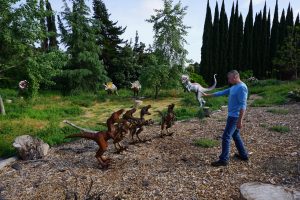As you remember from earlier posts May 3rd & 10th “Road Trip with Kevin the T-Rex Hatchling” & “Kevin at the Imperial Show”, six New Dinosaurs joined the Park in early May. Four of the six are Raptors! These are larger than the two little guys from Nipomo, California Miners that came to the Park in January. They are over 5 feet long vs. 4 feet and 30-inch hip height vs. 18 inches. The little Raptors from Nipomo fall into the Velociraptor size range. The new Raptors are in the Dromaeosaurus size range for adults. Or they could be juvenile Deinonychus or Utahraptors. Dromaeosaurus (Swift Running Lizard) roamed during the Late Cretaceous Period between 76.5 and 74.8 million years ago in the Western United States & Alberta, Canada.
As mentioned in the post March 8th “Finishing the Raptors & More Fun Facts” (regarding the little raptors), the Jurassic Park & World movies did an incredible job bringing Dinosaurs back to life at the theaters. However, some of the details got lost in the excitement. Velociraptors were not that Large. Even the Dromaeosaurs wouldn’t reach the average human’s waist in hip height. Although a Deinonychus could certainly reach the size of the movie Raptors and Larger!
Deinonychus was discovered in 1964. Deinonychus was about 10 feet long and weighed around 176 – 220 pounds! Its skeleton reflects it was designed for speed. A mouth full of razor-sharp teeth, a massive brain and large eyes making Deinonychus the perfect predator. The forelimbs were longer than most other theropods with three fingers ending with menacing claws. Along with those deadly inner toe claws we have all had nightmares after seeing the movies. If that weren’t scary enough here comes Utahraptor with all the speed & weapons of Deinonychus and other raptors, but 20 – 23 feet long weighing in at 1540 – 1875 pounds!
There are a number of Raptors in the Dromaeosaurinae Family not mentioned above – Atrociraptor, Achillobatar and Dakotaraptor. More to dig up on these Raptors later.
Back to the latest at the Park. Your Dinosaur will have different levels of rust depending on where and when You adopted it. I lined up the 4 Raptors to demonstrate the various levels of rust even when they were all adopted from the same place and had been there for the same amount of time. Unfortunately, Alan had been bathing by a water fountain at the Miners in Atascadero for a while. So, he will be the first to get a makeover. Alan after Dr. Alan Grant from the 1st & 3rd “Jurassic Park” movies.
First a wire brushing. Remember protect your eyes! A hat is a good idea to keep the rust dust out of your hair too. The leather gloves are great for moving the dinosaur. However, the blue nitrile gloves provide better flexibility working with the brushes. The blower & dusting brush help keep the area clean as well as the dinosaur. An assortment of wire brushes allows you to reach tight spots. I taped a tooth brush to one of the smaller wire brushes to aid in the process, as well. I start with the dinosaur on its side to ensure reaching all the underside areas.
Next step acid wash. Remember to make sure you cover up and protect your eyes. The spray bottle is great for getting the hard to reach areas. The brushes assist with working the material into the heavily rusted areas. I always start with the Dinosaur on its side to get the bottom part of the frame and inside the legs. When you return it to its upright position the material can drain. Let set overnight.
Stay Tuned for More on Alan’s Makeover and other Raptor Tales!
Remember “Antarctic Dinosaurs” are waiting for You at
The Natural History Museum in Los Angeles
This is a Special Exhibit!
“Encouraging the Appreciation of Art and Education through the Inspiration of Dinosaurs”
Paul & Prehistoric Pals
Your feedback is appreciated, Thank you!
